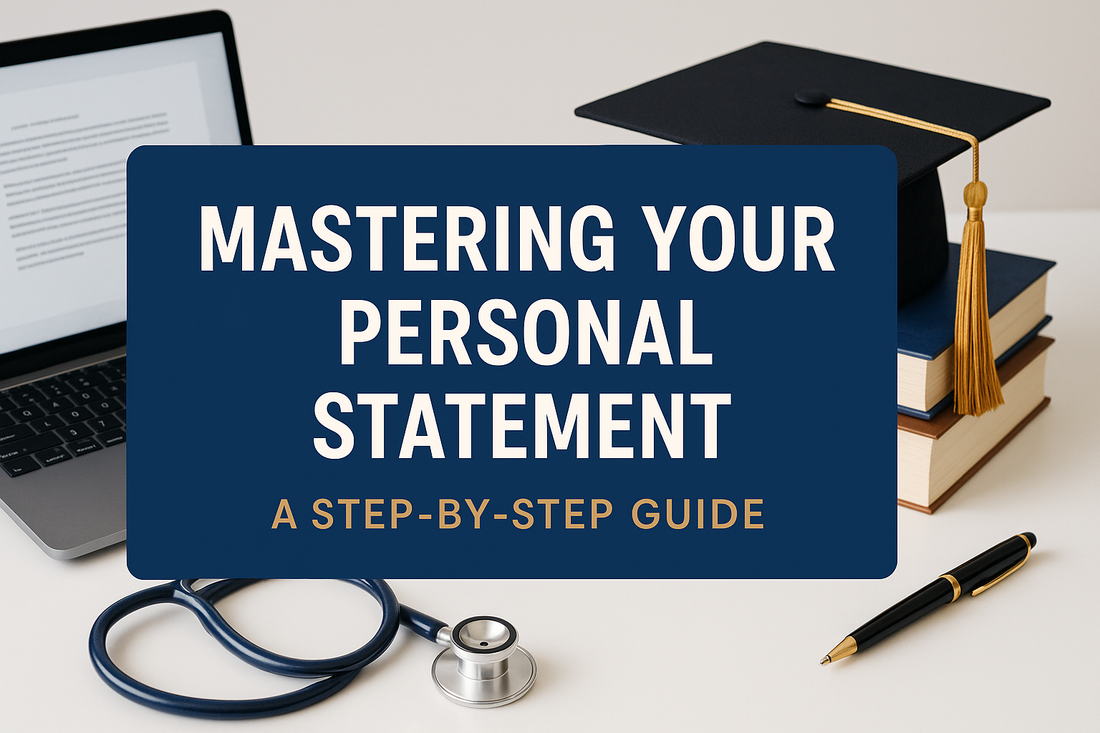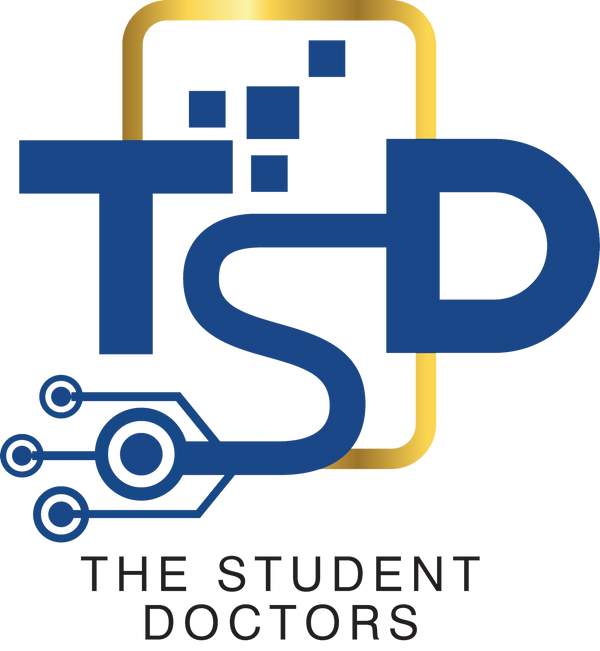
Mastering Your Personal Statement: A Step-by-Step Guide
Share
The Ultimate Personal Statement Outline: A Digital Template for Medical, Law, and Business School Applicants
Your personal statement can make or break your professional school application. Whether you're applying to medical school, law school, or business school, a strong personal statement outline is your foundation for success. This guide provides a proven template to help you craft a compelling narrative that stands out to admissions committees.
Why a Personal Statement Outline Matters
Before you start writing, creating a structured personal statement outline saves time, reduces anxiety, and ensures your essay flows logically. A solid outline helps you:
- Maintain focus on your central story
- Balance personal experiences with professional goals
- Avoid rambling or being too generic
- Meet word count requirements efficiently
- Identify and fix weak sections early
Whether you need a medical school template or are crafting a law school personal statement, the fundamental structure remains similar—though the content emphasis will differ based on your field.
The Three-Part Personal Statement Structure
Every compelling personal statement follows a proven three-act structure. Here's how to organize yours:
Part 1: The Opening Hook (10-15% of your essay)
Your opening must immediately capture attention. Admissions officers read hundreds of essays—yours needs to stand out from the first sentence.
- A specific, vivid moment that illustrates your motivation
- A surprising insight that reveals your thinking
- An authentic voice that sounds like you
- Sensory details that bring readers into the scene
Start with a specific moment using sensory details—what did you see, hear, feel? Then bridge to why this moment matters.
"When [specific event], I [your reaction/realization]. This experience revealed [insight about the field] and set me on a path to [professional goal]."
Part 2: The Body - Your Journey (70-80% of your essay)
This section proves you're qualified, motivated, and ready for professional school. Organize it into three subsections:
Early Experiences (2-3 paragraphs)
Discuss the experiences that first drew you to your field. Authenticity matters more than drama.
- Patient interactions during volunteering or shadowing
- Research projects that sparked scientific curiosity
- Personal or family health experiences
- Community health initiatives
- Experiences with justice, advocacy, or policy
- Moments witnessing legal systems in action
- Debates, mock trial, or related activities
- Personal experiences with legal issues
- Entrepreneurial ventures or internships
- Leadership roles in organizations
- Problem-solving in professional settings
- Moments identifying business opportunities
Deepening Commitment (2-3 paragraphs)
Show progression. Admissions committees want to see you've actively explored your field and developed relevant skills.
"To deepen my understanding, I [action taken]. In this role, I [specific accomplishment]. When faced with [challenge], I [how you responded], which taught me [lesson]. This reinforced my belief that [connection to goals]."
Key elements to include:
- Specific roles and responsibilities you've undertaken
- Challenges you've faced and overcome
- Skills you've developed relevant to your profession
- How experiences built upon each other over time
Integration and Insight (1-2 paragraphs)
Demonstrate maturity and self-awareness. Reflect on what your experiences have taught you about yourself and the profession.
Address these questions:
- What patterns emerged across your experiences?
- What unique perspective will you bring?
- How have you grown personally and professionally?
- What aspects of the profession align with your strengths?
Part 3: The Conclusion (10-15% of your essay)
Your conclusion ties everything together and looks toward the future. This isn't just about getting in—it's about what you'll do once you're there.
"As I prepare for [type of school], I'm excited to [specific opportunities]. My goal is to [short-term objective], which will prepare me to [long-term vision]. Just as [callback to opening], I now [forward-looking statement]."
What to include:
- Why this specific program (for school-specific essays)
- Short-term goals during your education
- Long-term vision for your career
- A closing thought that echoes your opening
Writing Strong Examples: Before and After
Weak Opening Example
Why it fails: Generic, could apply to anyone, tells rather than shows, uses clichés.
Strong Opening Example
Why it works: Specific scene, shows rather than tells, demonstrates unique perspective, creates interest.
Common Personal Statement Mistakes to Avoid
- Writing what you think they want to hear - Be authentic instead
- Listing achievements without context - Explore 2-4 experiences deeply
- Focusing only on others - Make it about YOUR growth
- Being too humble or too boastful - Let accomplishments speak through examples
- Using clichés - "For as long as I can remember," "Making a difference" (without context)
- Poor grammar and typos - Proofread obsessively
- Ignoring word count - Stay within 5% of the maximum
The Writing Process: From Outline to Final Draft
Step 1: Brainstorm (Don't edit yet)
Free-write about your experiences. Answer: What moments genuinely moved you? What challenges have you overcome? What makes you different?
Step 2: Map Stories to Your Outline
Identify 2-4 key stories that best illustrate your journey. Ensure each story shows growth and connects to your goals.
Step 3: Write Your First Draft
Use your outline as a roadmap. Focus on getting ideas down—don't worry about perfection yet.
Writing tips:
- Use active voice: "I organized" not "It was organized"
- Show, don't tell: Describe moments that demonstrate qualities
- Be specific: "Assisted 15 patients daily" not "helped many patients"
- Vary sentence structure for readability
Step 4: Revise for Content
Wait 24 hours, then evaluate: Does my opening grab attention? Does each paragraph advance my narrative? Have I provided specific examples? Does my conclusion tie back to my opening?
Step 5: Edit for Clarity
Read aloud to catch awkward phrasing. Eliminate redundant words like: very, really, just, quite, actually, basically.
Step 6: Get Feedback
Share with 2-3 trusted advisors. Ask: What's your main takeaway? Where did you lose interest? Does this sound authentic?
Step 7: Final Polish
Make final revisions, proofread multiple times, verify formatting, and have someone else check for errors you missed.
Customizing by Field
Medical School Template Emphasis
Medical schools seek students who combine scientific curiosity with genuine compassion. Emphasize:
- Patient-centered experiences showing empathy
- Scientific engagement through research or study
- Understanding of healthcare challenges
- Resilience through challenging experiences
- Teamwork in healthcare settings
Word count: Most medical school personal statements are 5,300 characters (about 600-700 words) for AMCAS.
Law School Personal Statement Emphasis
Law schools evaluate critical thinking, communication, and advocacy. Emphasize:
- Analytical thinking through problem-solving
- Written and oral advocacy experiences
- Understanding of legal systems and their impact
- Intellectual curiosity about law and justice
- Leadership in pursuing change
Word count: Typically 500-1,000 words, most schools prefer 2 pages double-spaced.
Business School Template Emphasis
Business schools want transformative leaders. Emphasize:
- Leadership experiences with measurable outcomes
- Business acumen through work or ventures
- Team building and collaboration
- Innovation and problem-solving with impact
- Career progression showing increasing responsibility
Word count: MBA essays vary widely, typically 250-750 words per essay.
Timeline for Success
6-8 months before deadline: Brainstorm experiences, create outline
4-6 months before: Write first draft, let it sit, begin revisions
2-3 months before: Get feedback, complete second and third drafts
1 month before: Final polish and proofreading
2 weeks before: Submit with buffer time
Quick Formatting Checklist
- Font: Times New Roman, Arial, or Calibri, size 11-12
- Spacing: Usually double-spaced (verify requirements)
- Margins: 1-inch on all sides
- File format: PDF unless specified otherwise
- File name: FirstName_LastName_PersonalStatement.pdf
Final Thoughts
Your personal statement is more than an application requirement—it's your opportunity to control your narrative. Using this personal statement outline, you can craft an essay that authentically represents who you are and why you're pursuing professional education.
Remember these principles:
- Be authentic: Write in your own voice
- Be specific: Details make your essay memorable
- Be reflective: Show what you learned and how you grew
- Be forward-looking: Connect past to future goals
- Be yourself: The right program wants YOU
Ready to Start Your Personal Statement?
Don't wait until deadline pressure forces rushed work. Begin your personal statement outline today.
Your action plan:
- Block out 30 minutes for brainstorming
- List 5-7 significant experiences
- Identify 2-3 central themes
- Draft your opening scene with specific details
- Share your outline with a trusted advisor
Need more guidance on professional school applications? Visit www.thestudentdoctors.com for comprehensive resources, advice, and support throughout your journey.
